- By Dan Veaner
- Around Town
 Print
Print 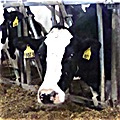 There is a long line to get on the carousel. Most of the riders are less than eight years old, and all of them are girls. They love the carousel -- some try to get right back on after their turn has come to an end. This is a scenario that sounds familiar to parents, but there the similarity ends because these girls leave the carousel a good 30 or so pounds lighter, and they repeat this ride three times a day in well spaced intervals. These girls are dairy cows and the carousel is a 61 foot diameter milking carousel.
There is a long line to get on the carousel. Most of the riders are less than eight years old, and all of them are girls. They love the carousel -- some try to get right back on after their turn has come to an end. This is a scenario that sounds familiar to parents, but there the similarity ends because these girls leave the carousel a good 30 or so pounds lighter, and they repeat this ride three times a day in well spaced intervals. These girls are dairy cows and the carousel is a 61 foot diameter milking carousel."You always look towards the future," says Skip Hardie, one of four partners that own Walnut Ridge Dairy, one of North Lansing's larger dairies. "The anticipation is that this farm will continue to be successful and grow. We built the last milking parlor in 1989. I won't say we never thought we'd grow too big for that, but that's what happened. This is a lot bigger than we need today."
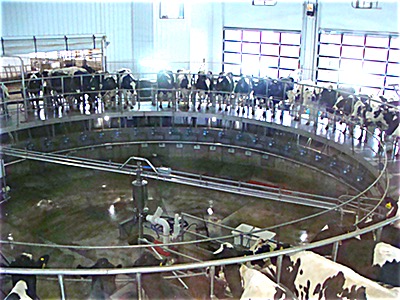 This 61-foot diameter milking carousel is unique in Tomplkins County. It is capable of 2,200 cows three times per day at full capacity. Walnut Ridge Dairy currently milks 1230 cows per day, so there is plenty of room for the herd to grow.
This 61-foot diameter milking carousel is unique in Tomplkins County. It is capable of 2,200 cows three times per day at full capacity. Walnut Ridge Dairy currently milks 1230 cows per day, so there is plenty of room for the herd to grow.This milking carousel is unique in Tompkins County. Hardie estimates there are fewer than a dozen in the entire state. Installation began last April, and it was ready for its first group of cows by November. Switching to the new milking parlor was baffling at first, both to the cows and the humans. Hardie's partners Steve Palladino, John Fleming, and Keith Chapin belonged to the same fraternity at Cornell, so they had a built-in source of strong bodies to help train the cows, physically pushing them onto the carousel. Even with the extra help it wasn't easy.
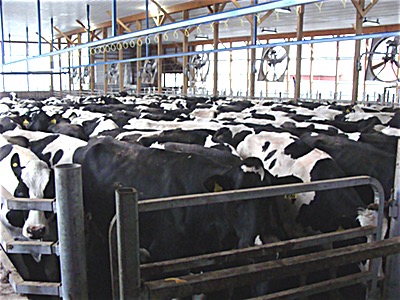 Cows are brought to this holding area, from which they are funneled onto the carousel for milking. the holding area can hold up to 200 cows at a time.
Cows are brought to this holding area, from which they are funneled onto the carousel for milking. the holding area can hold up to 200 cows at a time.| Open House: You can see the unique milking carousel for yourself at an open house May 14th and 15th, 3pm - 5pm. "We want to be quite transparent about who we are and what we do, and why we do what we do," says Skip Hardie. "We love being dairy farmers. This is a way for us to have people come see this." | ||
"Initially the cows didn't want to get off," Hardie says. "We tried different things, and then put up an electric fence gizmo that worked great. They are teeny little chains, and if the cow touches one she is going to get a mild shock. It was amazing how quickly some of these cows, the second time we milked them went 'Oh I remember this. This is pretty cool!' It's almost been more of a challenge to train the people milking the cows."
Today it is just part of their routine. The cows are divided into 13 groups. They are brought over one group at a time from one of four large barns nearby. They wait in a holding area that leads to the carousel. Each cow has a band around her hind leg that collects data, a kind of Fitbit for cows. These bands transmit data to the carousel reads, displaying the cow's identification number on a digital readout.
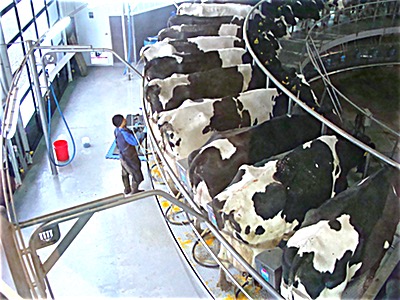 A worker attaches teat cups to cows as the turntable revolves to his station.
A worker attaches teat cups to cows as the turntable revolves to his station.One person is stationed just behind the cows where they first get on the carousel. The next person stimulates the four teats to simulate a sucking calf, and applies iodine foam on each. Another worker's responsibility is to wipe the cow clean with a cloth towel to make sure the teat is clean and dry, and the next one applies the unit.
"Each of those positions is spaced at a specific interval to help with the milk let down with the cow," Palladino says. "By the time the machine goes on the cow is ready to start letting down. The numbers flashing on each unit are recording the pounds of milk -- they show how much milk is flowing through that hose."
Immediately a readout begins to display the number of pounds of milk that is being extracted. At the same time this data is being collected to be used not only to track each animal's productivity, but also to help monitor its health. The band also records the number of steps each cow takes and monitors its activity level and transmits the data to a central computer.
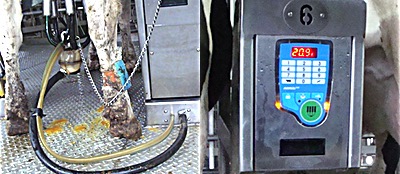 A Fitbit for cows? A blue device banded around the cow's hind leg collects and transmits data that identifies the cow and records its activity and location. This data can be accessed in real time, including the volume of milk as it flows through the milking machine.
A Fitbit for cows? A blue device banded around the cow's hind leg collects and transmits data that identifies the cow and records its activity and location. This data can be accessed in real time, including the volume of milk as it flows through the milking machine."With that information we can make the decision whether the cow is sorted to be bred, whether she's sick," General manager Steve Palladino explains. "If she has a sore foot we can use that activity information to make decisions on how to manage the herd. The computer will flag her because she deviated from that baseline. She's not moving as much so chances are she's got a sore foot, or she's sick. If the activity is really high it may be indicating that the cow is in heat. Then we can sort that cow out and breed her in a timely way."
Of course there's an app for that -- the data on each cow can be accessed by the farmers on their phones. It displays information on each cow and its current location. Each barn has an antenna so that real-time data is available.
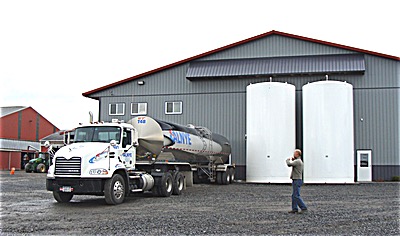 From cow to store shelf -- the milk is piped into one of two large tanks outside the milking parlor building, where it is immediately pumped into a truck bound for a processing facility. Skip Hardie says that milk should be 48 hours old at most when it hits the store shelves.
From cow to store shelf -- the milk is piped into one of two large tanks outside the milking parlor building, where it is immediately pumped into a truck bound for a processing facility. Skip Hardie says that milk should be 48 hours old at most when it hits the store shelves."We produce some of the cleanest milk possible," Hardie says. "Anything that milk can touch is kept clean as a whistle. We're very proud of that. We actually get a small premium for making milk this clean. The benefit of clean milk is it tastes great. And if it's being made into yogurt or cheese it makes a better quality product."
 At first calves are fed milk. They are switched to silage when they are old enough.
At first calves are fed milk. They are switched to silage when they are old enough.It's great to be born a cow. They are well cared for in four large, clean barns, with plenty to eat and lots of company. They ride the carousel three times a day, following a predictable routine, which cows like. The females are kept in a special barn until they have grown enough to have their first calf and join their mothers in the milking routine.
It's not as much fun to be born a bull. Artificial insemination has made them somewhat redundant on dairy farms. They are kept in a segregated barn to be sold to farms that will raise them for beef.
After the first calf is born the mother is impregnated again about three months later. If they get pregnant they milk for about seven months, take a two month 'dry period', then have a calf and start lactating again. The cows are milked three times a day, averaging about 96 pounds of milk each day. Some produce less, but others approach 200 pounds per day. And they need to be milked whether the carousel is working or not, so it has to work. If there is a mechanical problem it can be turned manually to get the cows off. When the power goes out, as it often does in Lansing, a giant generator powers it.
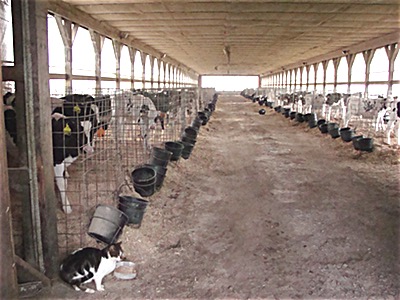 The barn cats are no fools. They are ready and waiting when it's time for the calves to be given their milk.
The barn cats are no fools. They are ready and waiting when it's time for the calves to be given their milk.The capacity of the carousel is enormous. 2,200 cows could be milked three times per day each day. The farm currently milks 1,230 cows each day, which means there is plenty of room for expansion. Each of the three shifts currently takes about four or four and a half hours, leaving plenty of time to milk more cows in the future. The farm actually has 1,380 cows. 150 are taking a break.
"They're actually on vacation," Palladino explains. "It's called a 'dry period'. It's about two months when the cows are not milked because it's the last two months of their pregnancy. So they go on vacation."
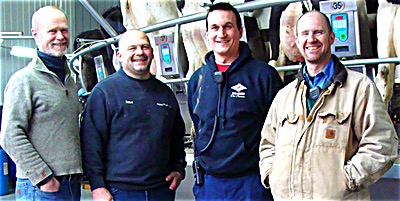 The Walnut Ridge Dairy partners are (left to right) Skip Hardie, Steve Palladino, Keith Chapin, and John Fleming
The Walnut Ridge Dairy partners are (left to right) Skip Hardie, Steve Palladino, Keith Chapin, and John FlemingWith the recent passage of Lansing's Agriculture and Farmland Protection Plan and the current updating of its Right To Farm Law there has been a lot of talk about farming in the township, but few realize what a big business it is. Walnut Ridge Dairy is one of 40 Lansing farm businesses that collectively generate $20 million in agricultural product sales annually. That is nearly a third of all farm revenue in Tompkins County. 11 of those farms are dairies that together generate $17 million per year from milk, cattle and crops and are responsible for most of the approximately 100 farm jobs in Lansing. Dairy farming it the top farm business in Lansing, followed by field crops and then greenhouse and nursery sales.
Walnut Ridge Dairy was originally Hardie Farms, established by Hardie's father David in 1951. The farm totals about 2,100 acres that are either owned or rented. Hardie is recently retired. His three partners are actively farming: Palladino is the General Manager, Fleming is the Crop and Machinery Manager, and Chapin the Herd Manager.
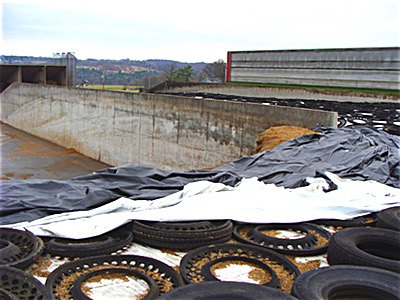 Large bays store silage made from crops grown on the farm. This bay is nearly empty after the Winter, but adjoining bays are full.
Large bays store silage made from crops grown on the farm. This bay is nearly empty after the Winter, but adjoining bays are full.About 800 acres are used to grow hay and about 1,300 acres for corn. The crops are harvested as silage, a finely chopped, fermented food that is a staple of the cows' diet. If you have ever passed a farm and seen a giant pile of something covered with tarpaulins that are held down by old tires, you are looking at stored silage. Walnut Hill Dairy has several bays full.
The farm ships 116,000 pounds of milk per day. Tanker trucks are filled there, then transport the milk to Cayuga Milk ingredients, a plant in Auburn where it is pasturized. The cream is separated and divvied up to be turned into other products such as cream cheese, or ice cream. The plant is co-owned by Walnut Ridge Dairy and about two dozen other farms.
"The plant uses the protein portion and processes that into many different dairy protein ingredients, ranging from 3% protein Non Fat Dried Milk (NFDM) up to 90% protein Milk Protein Isolate (MPI)," Hardie says. "These ingredients are used in many different high quality food products, including infant formulas and geriatric nutritional foods."
If you think about it, dairy farmers' job is to wait on cows and make sure they are happy, similar to running a luxury hotel. They make sure the cows live a routine, safe life -- Hardie notes that cows love routine. They provide room service with just the right food, and maid service to keep the barns clean. There is even a back-scratcher device hanging in the barns for the cows' comfort. In return the farmers get a quality product, a way to make a good living that is sustainable for their families and sustainable for the land. They grow crops to feed the cows, who produce manure to nourish the crops. The milking carousel was certainly a costly investment, but one that pleases both humans and cows -- humans because it make milking more efficient and provides plenty of room for expansion, and the cows because... well, really, do you know anyone who doesn't love riding on a carousel?
"We could have built a bigger parlor like the one we moved out of," Hardie says. "It would have cost less money, but when we visited these (revolving) parlors we could see the cows enjoyed being on them. You want to make sure that they enjoy what they're doing and have a reason to be happy."
v12i16



